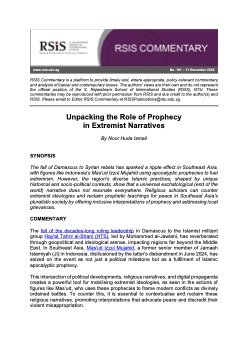By Noor Huda Ismail
The fall of Damascus to Syrian rebels has sparked a ripple effect in Southeast Asia, with figures like Indonesia’s Mas'ud Izzul Mujahid using apocalyptic prophecies to fuel extremism. However, the region's diverse Islamic practices, shaped by unique historical and socio-political contexts, show that a universal eschatological (end of the world) narrative does not resonate everywhere. Religious scholars can counter extremist ideologies and reclaim prophetic teachings for peace in Southeast Asia’s pluralistic society by offering inclusive interpretations of prophecy and addressing local grievances.
Singapore: S. Rajaratnam School of International Studies (RSIS), 2024. 4p.





















